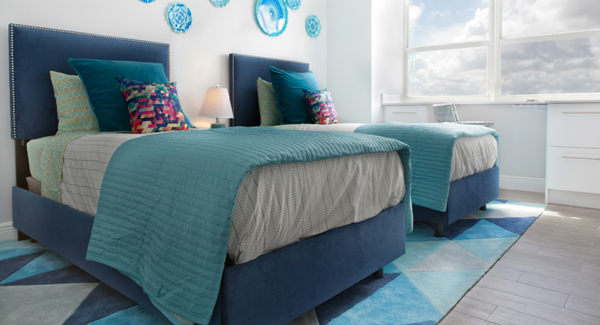Article navigation
- Published:
- Written by: Tony Brown
- Topic: Beds
When choosing a new bed, there are various factors to consider, but mattress size is often overlooked. Whether you sleep alone or share a bed with someone, there should be sufficient space for each person.
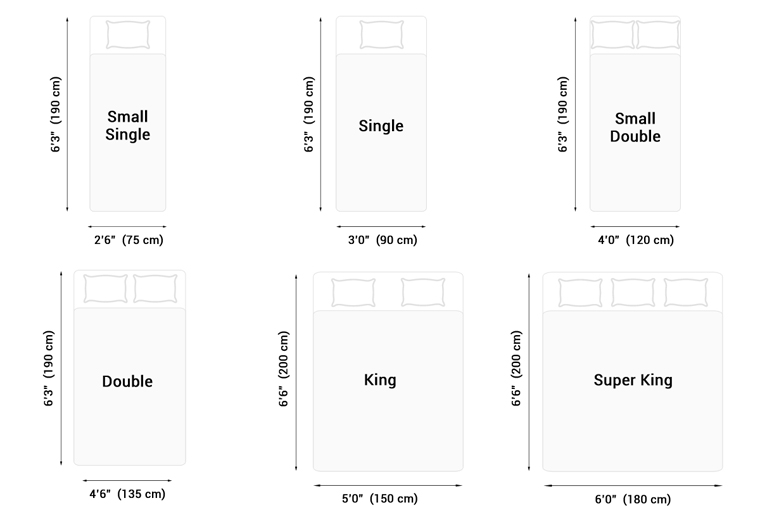
Bed sizes UK
There are six typical bed sizes in the UK:
| Bed / Mattress Size | Dimensions (Imperial) | Dimensions (Metric) |
|---|---|---|
| Small single | 2’6” x 6’3” | 75 cm x 190 cm |
| Single | 3’0” x 6’3” | 90 cm x 190 cm |
| Small double | 4’0” x 6’3” | 120 cm x 190 cm |
| Double | 4’6” x 6’3” | 135 cm x 190 cm |
| King size | 5’0” x 6’6” | 150 cm x 200 cm |
| Super king size | 6’0” x 6’6” | 180 cm x 200 cm |
Because there is no UK standardisation, bed sizes may vary from one manufacturer to the next. So, it is important to double-check the dimensions of the bed before ordering.
Small single bed size
A small single bed measures 2’6” x 6’3” (75 cm x 190 cm). This size bed is ideal for smaller rooms. It is also suitable for a child moving out of a cot into their first bed, as the bed provides more sleeping space and better support for their growing bodies.
A small single bed will usually cost the same as a standard single bed (90 cm x 190 cm).
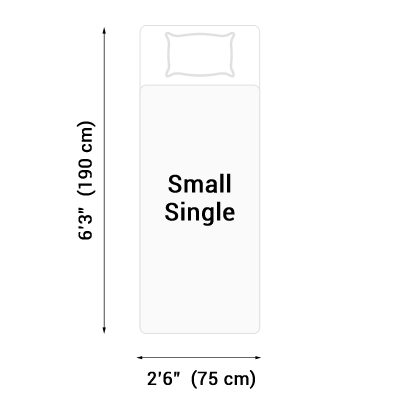
Single bed size
A single bed measures 90cm x 190cm (3’0” x 6’3) and is suitable for a single person.
For couples who prefer to sleep in separate beds, twin beds (two singles) are popular, particularly among older adults. Twin beds can be positioned side by side in one room or moved into separate rooms where necessary.
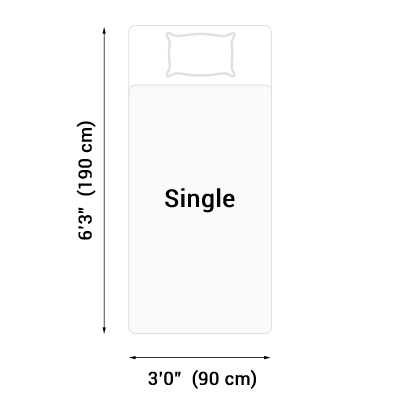
Small double bed size
A small double bed, also known as a three-quarter size bed, measures 4’0” x 6’3” (120cm x 190cm). 4’0” beds are ideal for teenagers moving out of a single bed or for a small spare room. 4’0” beds are usually the same price as a standard double bed (135 cm x 190 cm).
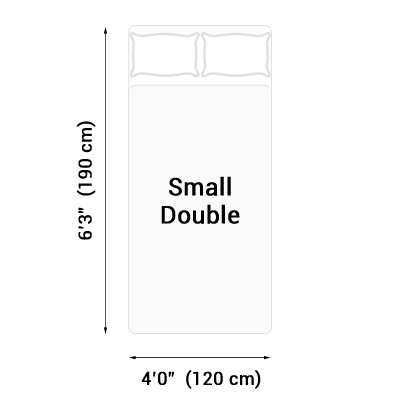
Double bed size
A standard double bed measures 4’6” x 6’3” (135cm x 190cm) and is suitable for two adults sharing a bed with limited room space.
Most couples still sleep in a double bed. One of the main reasons for this is that modern homes are getting smaller as developers try to cram more properties onto the available land.
A standard double bed only gives each person 2ft 3 inches of sleeping space, less than a baby gets in a cot. Double beds are ideal for couples who don’t mind getting cosy in bed.
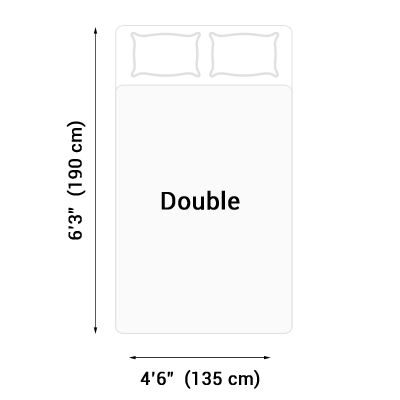
King size bed size
A King size bed measures 5’0” x 6’6” (150cm x 200cm). King sized beds are longer than single and double sized beds and are ideal for taller people requiring more legroom.
The extra width you get from upgrading to a king sized bed can make a significant difference compared to a double bed.
It usually doesn’t cost much more to upgrade from a double to a king size bed. Some manufacturers may even offer an upgrade, allowing you to buy the king size model for the same price as the double.
Some king size mattresses are available in split tensions, allowing each partner to have their side of the mattress in their preferred firmness. For example, one side soft, the other medium. Split tension mattresses are ideal for sleeping partners of different weights or with different comfort preferences.
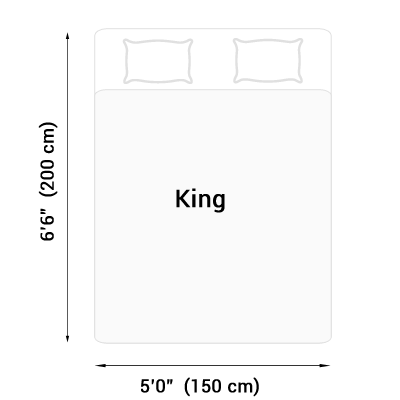
Super king bed size
It goes without saying we need bigger beds for better sleep. A super king size bed measures 6’0” x 6’6” (180 cm x 200 cm).
It is the largest of the UK’s typical bed sizes and is perfect for couples that value their sleeping space. There’s plenty of room to stretch out, and sleeping partners are less likely to disturb one another in bed.
Be mindful that super king size mattresses are much heavier and are harder to turn and move. You must also ensure the mattress can be lifted into the required room by measuring doorframes, stairs and access points.
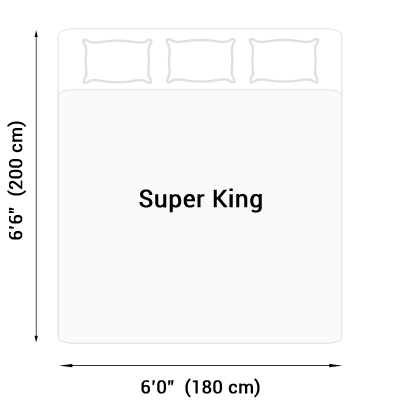
Zip and link
Another option is to consider a zip and link bed which allows two single beds to be zipped together to create a king or super king size bed. Zip and link is a versatile option allowing couples to sleep together or apart.
Since the mattresses are separate, each person has a choice of mattress tension depending on their comfort preferences and support needs. This is particularly beneficial for couples of vastly differing weights. For instance, one person could have a soft mattress, the other a firm mattress. Partner disturbance is eliminated as each bed is separate.
As the beds split into two, it is easier to turn the mattresses and move the beds for cleaning. Zip and link beds are popular for homes with limited access, where a one-piece mattress is out of the question.
Bed base sizes
Bed base sizes should correspond with the mattress size they are intended for. For example, a double bed frame will hold a double mattress.
The dimensions of the base will vary depending on its style. Divans are a popular type of base and are usually the same size as the mattress. However, you will need to allow extra room if you have drawers or attach a headboard to the bed.
Bedsteads usually take up more space than a divan because the mattress usually sits inside the frame. Sleigh beds that feature a curved headboard and footboard can significantly increase the overall length of the bed, sometimes adding up to an extra foot in length.
When the mattress sits inside the frame, there is sometimes a slight gap between the mattress and the outer frame.
Finally, when a new mattress is delivered, it can sometimes appear shorter than the base. This usually happens because of how the mattress is stored during transit. However, it should return to its expected size with use.
Whichever bed you choose, remember to check its dimensions before purchasing.
Bed height
Bed height tends to be more important for older adults or those with mobility issues to ensure they can get in and out of bed comfortably. In contrast, younger adults typically prefer the style of the bed over its comfort or height.
A lower bed may be more suitable for a child moving out of a cot into their first bed in case they fall out of bed.
What size is queen size?
‘Queen’ size often causes confusion within the UK as the term is not commonly associated with any specific UK bed size. It is a term used in the United States to describe mattresses that measure 150 cm x 203 cm. The closest equivalent in the UK is a king size (150 cm x 200 cm), which is likely where the confusion comes from.
Some UK retailers may refer to their mattresses as ‘queen’, but as mattress sizes can vary from one retailer to the next, it’s best to double-check the exact dimensions.
How big is an emperor size bed?
An impressive centrepiece for a spacious bedroom, an Emperor sized bed measures 7 feet square (215 cm x 215 cm).
There are only a handful of bed manufacturers that provide this size. If you’re looking for a luxurious bed with plenty of sleeping space, an emperor size bed is an excellent choice.
Made to measure mattresses
There may be some circumstances where you need a special-size mattress or bed. This could be for a caravan, an antique bedframe, an unusual space, or an extra-long bed for a taller person.
Some manufacturers offer a bespoke service where they can make beds and mattresses in any size. There is usually an additional charge for a bespoke bed or mattress, and you may also have to wait longer for delivery. But you can choose your preferred size without compromising on sleeping space.
What factors to consider when choosing bed size
The general advice is to choose as big a bed as the room allows, but there are various factors to consider before choosing your bed size.
Who is the bed for?
Partner disturbance is one of the main reasons for poor quality sleep. If you share a bed with someone, a bigger bed may help you both sleep better.
There should be enough room for each person to lie on their back with their arms behind their head and elbows out without touching. The bed size should also be at least 4 to 6 inches longer than the tallest person.
Some adults choose to share the bed with their children or pets, so they will need a large enough bed to accommodate everyone.
On the other hand, a single or small double bed may be sufficient for a single person.
Body weight and build
Your body weight and build can influence the size of the mattress you need. A heavier person weighing sixteen stone with broad shoulders will typically require more sleeping space than someone that weighs eight stone.
Bedroom space
You also need to decide what size bed works for your bedroom. A bigger bed can dominate a smaller room, whereas a smaller bed may look lost in a larger space. There should also be sufficient space to move around the bedroom once the bed is in situ.
It is also important to check access points like doors, stairs and corners to ensure the bed will fit into the room.
Remember that beds always look smaller in showrooms, so it helps to measure the space thoroughly before ordering.
Also, be mindful that bed frames typically take up more room space as the mattress usually sits inside a frame. Check the frame’s dimensions carefully to ensure it comfortably fit into the space.
Mattress support
There’s no point investing in a bigger bed if the mattress doesn’t provide adequate support. An uncomfortable mattress may increase tossing and turning, making you more likely to disturb your sleeping partner in bed.
Cheaper mattresses are less effective at absorbing movement. Pressure is usually transferred across the entire sleeping surface, which means that when one person moves in bed, the other is likely to get disturbed. Sleeping partners may also feel like they are rolling together.
You should also consider edge support. Cheaper mattresses tend to sag around the edges, often making you feel like you’re falling out of bed. As a result, you may sleep more towards the middle of the bed, losing valuable sleeping space.
Higher-quality mattresses are often hand stitched, preventing the perimeter of the mattress from sagging. Hand-side stitching extends the overall sleeping area by providing effective edge-to-edge support.
Mattress weight
Mattresses can be heavy and difficult to move. The weight of a mattress is determined by its size and construction.
If you’re thinking about upgrading to a bigger bed, consider a non-turn mattress to keep physical effort to a minimum. Another option is a zip and link bed, where the mattresses can be unzipped, making them easier to lift.
On the hand, if you sleep alone, turning a mattress may seem like a daunting task. In this case, you may prefer a smaller bed which is lighter and easier to move.
Budget
You should spend as much as you can reasonably afford on a new bed. But as we buy beds infrequently, it can often be difficult to know how much to spend.
Bigger beds typically cost more than smaller sizes. However, there is often little difference in price between the double and king size models. Some manufacturers may even offer a free upgrade allowing you to purchase the king size model for the same price as the double.
Remember that beds are a worthwhile investment as they typically last between seven and ten years. So it’s often worth spending a little more to get a bigger size.
Finally, before setting your budget and deciding which size bed to choose, you may also need to factor in the costs of other products and services usually sold separately from the bed, such as bedding, headboards, and delivery charges.
Final thoughts
The size of the bed you choose can significantly impact your sleep quality. If you’re unsure what size you need, it may help to visit your local mattress store, where you can try a few beds and compare sizes to determine which is right for you.
Share this article

About the author
Tony Brown is the founder and creator of The Bed Consultant. His career in the bed industry began in 2002. After graduating from university with a degree in Business Administration, Tony joined one of the largest independent furniture retailers in the UK as a bed consultant. Tony has helped thousands of customers find the perfect mattress.

